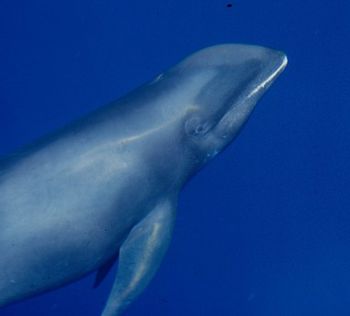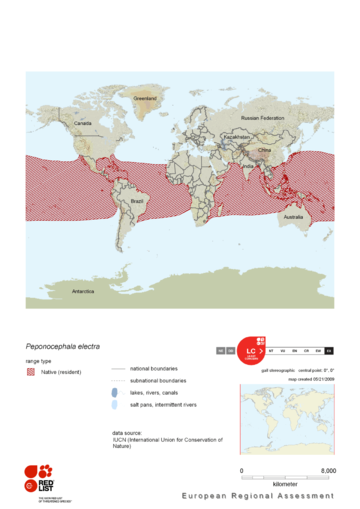Melon-headed whale (About the EoE)
Contents
Melon-headed whale
The Melon-headed whale (Peponocephala electra) is a dark gray cetacean that is actually a member of the family of Ocean Dolphins. It is smaller than almost all the other North American members of this family and is approximately the size of a Bottlenose dolphin. This whale lives in deep tropical and subtropical waters around the world and is relatively rare; the total population in the world is believed to be perhaps 10,000 to 50.000. They frequently school together in large herds (approximately 200 in number), and may associate with other small whales and dolphins. Their diet includes fish, squid, and sometimes crustaceans, similar to that of Fraser's dolphin with whom they often associate. They are very aggressive and do not survive well in captivity.
 Source: William Perrin, National Oceanic and Atmospheric Administration Source: William Perrin, National Oceanic and Atmospheric Administration
|
 Size comparison of an average human and a Melon-headed whale (Peponocephala electra). Source: Chris Huh Size comparison of an average human and a Melon-headed whale (Peponocephala electra). Source: Chris Huh
|
| Conservation Status: Data Deficient |
|
Scientific Classification Kingdom: Animalia (Animals) |
Physical description
Melon-headed whales are mostly dark grey in colour, with a faint, darker gray cape that narrows at the head on the dorsal side. Often, they exhibit a distinct dark eye patch that widens as it extends from the eye toward the melon; the lips are often white. Additionally, white or light grey areas are common in the throat region, from the blowhole to the top of the melon, and on the ventral side.
The bodies of melon-headed whales are shaped like torpedos and are similar in size toFeresa attenuata, making it difficult to distinguish between the two in the field. The head ofPeponocephala electrais shaped like a rounded cone, but lacks the clearly defined beak often seen in dolphins. The beak is longer and more slender than that of dolphins and it lacks the typical saddle or cape markings seen in many dolphins. The head is narrow and tapers, but the bump of the melon gives it a curved profile. The flippers are relatively long, estimated to be about 20% of the body length. They are smoothly curved and sharply pointed at the end. This creates an obvious distinction from the rounded flippers ofFeresa attenuata. The dorsal fins ofP. electraare distinct, curved in the middle of the back with a pointed tip, and shaped very much like the dorsal fin ofTursiops truncates. Additionally,P. electrahas 82 vertebrae, the first three are fused together.
Melon-headed whales have 20 to 25 teeth in each upper toothrow, compared to eight to thirteen inFeresa attenuata. The teeth ofP. electraare small and slender while those ofFeresa attenuataare larger and more robust. This difference in dentition is the key identifier betweenFeresa attenuataand melon-headed whales.
Peponocephala electrais small to medium sized, averaging 2.6 meters in length in both males and females (no sexual dimorphism exists). The maximum length is about 2.75 meters, and the average length at birth is estimated to be 1.00 to 1.12 meters. The average weight is 228 kg (maximum 275 kilograms). At birth, the average young weights about 15 kg. The basal metabolic rate ofPeponocephala electrais is not known.
In the wild, melon-headed whales can be identified by a lower fin, lack of patch on the chin, and a pointed, rather than rounded, flipper compared toFeresa attenuata. Melon-headed whales look around with their head out of the water, but do not sit up as high as other species. Nevertheless, it is difficult to distinguish melon-headed whales fromFeresa attenuata.
Reproduction
Little is known about the reproduction ofPeponocephala electra; moreover, there is a paucLittle or nothing is known about the breeding habits, breeding season, or breeding interval of melon-headed whales. Calving appears to peak in either early spring in the low latitudes of both hemispheres or in July and August in higher latitudes, but it seems calves are born year round and most data are inconclusive. Nothing is known of the birthing habits of melon-headed whales (their close relatives,Feresa attenuata, generally have only a single calf). The length of gestation is not known, but probably about 12 months. Mass at birth is estimated to be between 10 and 15 kg, averaging around 12 kg. Nothing is known about the time to weaning specifics or independence. It is estimated that maturity is reached by about four years of age for both males and females.
Little is known of the parental habits ofPeponocephala electra, but it is assumed that mothers care for and nurse her young until they reach independence. As in otherCetacea, young are capable of swimming soon after birth.
Lifespan
Little is known about the lifespan or longevity ofPeponocephala electra. The longest known lifespan in the wild is over 30 years, but the exact age is not known. There are no individuals in captivity, nor have there ever been.
Behavior
Melon-headed whales are highly social and travel in large pods, usually of 100 to 500 individuals. Pods have been known to be as large as 2000 individuals. They typically move at high speeds, making low, shallow leaps out of the water regularly, creating lots of spray, and occasionally bow-ride for short periods of time (but they are usually wary of boats). They often travel with other species includingLagenodelphis hosei,Stenella longirostris, andStenella coeruleoalbadolphins. When traveling in groups, melon-headed whales are often tightly packed and change their course frequently.
Occasional stranding has been reported from Moreton Island and Crowdy Heads, Australia; Malekoula Island, Vanuatu; the Seychelles; Aoshima, Japan; Piracanga Beach, Brazil in 1990; the Kwajalein Atoll; and Tambor, Costa Rica. Although they are difficult to distinguish at a distance, once melon-headed whales are stranded they are easy to identify, as the teeth are unmistakable. Most of the information about this species comes from stranded individuals, as individuals are rarely seen in the wild. Currently, there are little data regarding migration; however, melon-headed whales are not thought to engage in significant migration. Nothing is known regarding territorial behavior.
Distribution
 Distribution of Melon-headed Whale. Source: IUCN Redlist Peponocephala electrais found in warm, deep, tropical, and subtropical oceanic waters between 40? North and 30? South, with most animals concentrated between 20? North and 20? South. WhilePeponocephala electrais most commonly found in the Philippine Sea, its range includes the Gulf of Mexico, Senegal, the Arabian Sea, the Bay of Bengal, the South China Sea, Taiwan, southern Honshu, the Hawaiian Islands, and Baja California Sur; and south to Espiritu Santo in Brazil, Timor Sea, northern New South Wales, and Peru. This range is extremely similar to that ofFeresa attenuata.
Distribution of Melon-headed Whale. Source: IUCN Redlist Peponocephala electrais found in warm, deep, tropical, and subtropical oceanic waters between 40? North and 30? South, with most animals concentrated between 20? North and 20? South. WhilePeponocephala electrais most commonly found in the Philippine Sea, its range includes the Gulf of Mexico, Senegal, the Arabian Sea, the Bay of Bengal, the South China Sea, Taiwan, southern Honshu, the Hawaiian Islands, and Baja California Sur; and south to Espiritu Santo in Brazil, Timor Sea, northern New South Wales, and Peru. This range is extremely similar to that ofFeresa attenuata.
There have also been reports by Mignucci et al. (1998) ofPeponocephala electrain the Caribbean sea. Other sources report individuals seen as far out of the typical range as southern Japan, Cornwall in England, Cape Province in South Africa, and Maryland in the USA. These individuals most likely come from populations in adjacent warmer waters and represent extreme cases of migration.
Habitat
The distribution of the rare, reported sightings of Melon-headed whales suggest that they are found primarily in equatorial and subtropical waters from the continental shelf seaward. They are most often found in deeper waters.
Feeding habits and predation
Little is known about predators ofPeponocephala electra. Their medium to large size prevents them from attracting many predators, but it is feasible that large sharks or cetaceans would not be deterred by size alone.
Peponocephala electrais an important predator of small fish and squid in pelagic waters, although highly detailed information is lacking.
Conservation status
This species may be regarded as threatened, due to the population value and the ongoing intensive harvesting by Japan. Hunting is a particularly significant threat, since the animals tend to aggregate in large herds, and hence many can be harvested in a short time with a single hunting vessel.
Peponocephala electrais categorized as a species of Least Concern by the IUCN Red List; there are many instances where the IUCN misclassifies species; in the case of the Melon-headed whale, the species may merit a more vulnerable status. A taxon should only be classified as Least Concern” when it is truly widespread and abundant.
Threats
Melon-headed whales are classified by CITES as an Appendix II species. They are not hunted intentionally except by the Japanese in their coastal waters; however, the species is s also accidentally caught in fishing nets. Some of the largest populations of the species are in the northern Gulf of Mexico, Hawaiian Islands and seas near Indonesia and the Philippines.
Melon-headed whales are important members of pelagic ecosystems. Humans occasionally catch them while targeting on another fishery, for example near the island of St. Vincent in the Caribbean Basin, in the Japanese dolphin drive fishery, near Lamalera, Indonesia, near Sri Lanka, and in the Philippines. The number of reported Peponocephala electrataken each year is misleadingly small. For instance, during the 1982 fishing season only four melon-headed whales were taken; it is almost certain that the number taken is under-reported, since the Japanese are under severe scrutiny for excessive and systematic taking of cetaceans. Once caught, melon-headed whales are used for bait or for consumption. These whales are typically caught and killed with hand harpoons or toggle-head harpoon shafts shot from spear guns.
In addition to killing of this species by humans, there are periodic episodes of mass strandings, which involve mortality of hundreds of individuals at a time; the causes of these strndings is not explained.
There are no known adverse effects ofPeponocephala electraon humans. Since they are so uncommon and swim in very deep water, it is rare that they collide with a boat; have an impact upon the species is not thought to interfere with fisheries important to humans.
References and Further reading
- Encyclopedia of Life. 2010. Peponocephala electra
- Pilleri, G. 1989. Investigations On Cetacea. Berne, Switzerland: Institute of Brain Anatomy.
- Body, I. 1993. Marine Mammals: Advances in Behavioral and Population Biology. Oxford: Clarendon Press.
- Mackintosh, N. 1965. The Stocks of Whales. Larkhall, Bath: Coward & Gerrish LTD.
- Gray, J. 1871. The Catalogue of Seals and Whales. London, England: Taylor and Francis.
- Norris, K. 1966. Whales, Dolphins, and Porpises. Berkeley, CA: University of California Press.
- Dutton, E. 1981. Whales of the World. New York, NY: Elsevier-Dutton Publishing Co Inc.
- 2009. "Melon-Headed Whale - MarineBio.org" (On-line). Peponocephala electra. Accessed March 29, 2009
- Culik, B. 2000. "Convention of Migratory Species (CMS): Whales and Dolphins" (On-line). Peponocephala electra. Accessed April 01, 2009
- Jefferson, T., S. Leatherwood, M. Webber. 1994. ". FAO species identification guide. Marine mammals of the world." (On-line pdf). Peponocephala electra. Accessed April 02, 2009
- Jefferson, T., N. Barros. 1997. Mammalian Species: Peponocephala electra. American Society of Mammalogists, 553: 1-6. Accessed April 05, 2009
- Rice, D. 1998. Marine mammals of the world: systematics and distribution. Society for Marine Mammalogy, 4: 1-2.
- Allen, C. 2008. "Animal Diversity Web" (On-line). Feresa attenuata. Accessed April 04, 2009
- 2009. "MarineBio" (On-line). Feresa attenuata: Pygmy Killer Whale. Accessed April 06, 2009
- Perryman, W. 2002. Encyclopedia of Marine Mammals: Melon-headed whale - Peponocephala electra. San Diego, CA: Academic Press.
- Jonsgard, A. e. 1968. The Whale. New York, NY: Simon and Schuster.
- IUCN Red List
